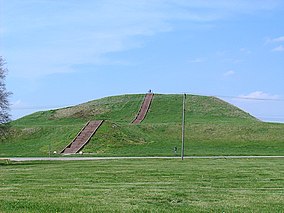
Back Cahokia Afrikaans كاهوكيا Arabic كاهوكيا ARZ Кэхокія Byelorussian কাহোকিয়া Bengali/Bangla Cahokia Mounds Catalan Cahokia Mounds State Historic Site CEB Cahokia Czech Cahokia German Cahokia Esperanto
| Cahokia Mounds State Historic Site | |
|---|---|
 Monks Mound, the largest earthen structure at Cahokia (for scale, an adult is standing on top) | |
| Location | St. Clair County, Illinois, U.S. |
| Nearest city | Collinsville, Illinois |
| Coordinates | 38°39′14″N 90°3′52″W / 38.65389°N 90.06444°W |
| Area | 2,200 acres (8.9 km2) |
| Governing body | Illinois Historic Preservation Division |
| Official name | Cahokia Mounds State Historic Site |
| Type | Cultural |
| Criteria | iii, iv |
| Designated | 1982 (6th session) |
| Reference no. | 198 |
| Region | Europe and North America |
| Official name | Cahokia Mounds |
| Designated | October 15, 1966[1] |
| Reference no. | 66000899 |
| Official name | Cahokia Mounds |
| Designated | July 19, 1964[1] |

The Cahokia Mounds State Historic Site /kəˈhoʊkiə/ (11 MS 2)[2] is the site of a pre-Columbian Native American city (which existed c. 1050–1350 CE)[3] directly across the Mississippi River from present-day St. Louis, Missouri. This historic park lies in south-western Illinois between East St. Louis and Collinsville.[4] The park covers 2,200 acres (890 ha), or about 3.5 square miles (9 km2), and contains about 80 manmade mounds, but the ancient city was much larger. At its apex around 1100 CE, the city covered about 6 square miles (16 km2), included about 120 earthworks in a wide range of sizes, shapes, and functions, and had a population of between 15,000 and 20,000 people.[5][a]
Cahokia was the largest and most influential urban settlement of the Mississippian culture, which developed advanced societies across much of what is now the Central and the Southeastern United States, beginning more than 1,000 years before European contact.[7] Today, the Cahokia Mounds are considered to be the largest and most complex archaeological site north of the great pre-Columbian cities in Mexico.
Cahokia Mounds is a National Historic Landmark and a designated site for state protection. It is also one of the 25 UNESCO World Heritage Sites within the United States. The largest prehistoric earthen construction in the Americas north of Mexico,[5] the site is open to the public and administered by the Illinois Historic Preservation Division and supported by the Cahokia Mounds Museum Society. In celebration of the 2018 Illinois state bicentennial, the Cahokia Mounds were selected as one of the Illinois 200 Great Places[8] by the American Institute of Architects Illinois component (AIA Illinois). It was recognized by USA Today Travel magazine, as one of the selections for 'Illinois 25 Must See Places'.[9]
- ^ a b Cite error: The named reference
nhlsumwas invoked but never defined (see the help page). - ^ Pursell 205
- ^ Munoz, Samuel E.; Schroeder, Sissel; Fike, David A.; Williams, John W. (2014). "A record of sustained prehistoric and historic land use from the Cahokia region, Illinois, USA". Geology. 42 (6): 499–502. Bibcode:2014Geo....42..499M. doi:10.1130/g35541.1.
- ^ Cahokia Mounds Homepage; Map of the Site
- ^ a b "Nomination – Cahokia Mounds State Historic Site, Illinois", US World Heritage Sites, National Park Service, accessed 2012-05-03
- ^ White, AJ. "Cahokia". The Office of Resources for International and Area Studies. UC Berkeley. Retrieved January 29, 2024.
- ^ WashingtonPost.com: Ancient Cahokia, Washington Post
- ^ Waldinger, Mike (January 30, 2018). "The proud history of architecture in Illinois". Springfield Business Journal. Retrieved January 30, 2018.
- ^ "25 Must See Buildings in Illinois". USA Today. August 9, 2017. Retrieved January 30, 2018.
Cite error: There are <ref group=lower-alpha> tags or {{efn}} templates on this page, but the references will not show without a {{reflist|group=lower-alpha}} template or {{notelist}} template (see the help page).
© MMXXIII Rich X Search. We shall prevail. All rights reserved. Rich X Search
